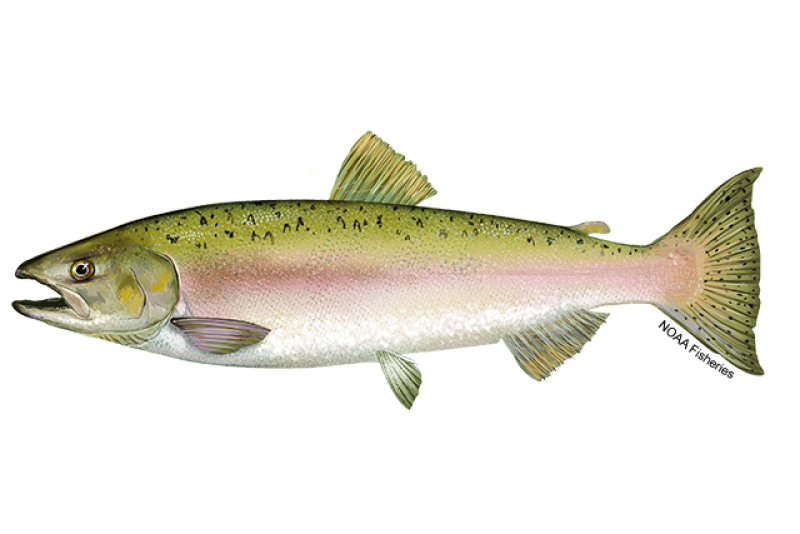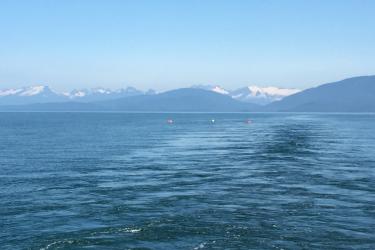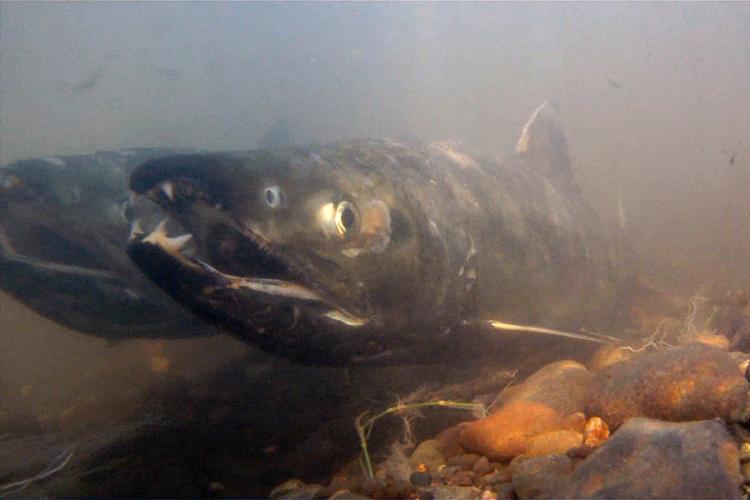 Chum salmon. Credit: NOAA Fisheries
Chum salmon. Credit: NOAA Fisheries
Chum salmon. Credit: NOAA Fisheries
About the Species
 Chum salmon. Credit: NOAA Fisheries
Chum salmon. Credit: NOAA Fisheries
Chum salmon. Credit: NOAA Fisheries
U.S. wild-caught chum salmon is a smart seafood choice because it is sustainably managed and responsibly harvested under U.S. regulations.
NOAA Fisheries works in cooperation with federal, state, tribal, and Canadian officials to manage these commercial, recreational, and tribal harvest of salmon and steelhead in ocean and inland waters of the West Coast and Alaska. To learn more about management of these fisheries, visit our West Coast and Alaska fisheries management pages.
However, some chum salmon are also protected under the Endangered Species Act. Learn more about protected chum salmon.
Appearance
- Chum salmon is one of the largest species of Pacific salmon, second only to Chinook salmon in size.
- When in the ocean, chum salmon are metallic greenish-blue along the back with black speckles, similar to both sockeye and coho salmon.
- As they enter fresh water, their appearance changes dramatically.
- Both sexes develop a tiger stripe pattern of bold red and black stripes.
- Males develop enormous canine-like fangs and their bodies have a striking calico pattern, with the front two-thirds of the flank marked by a bold, jagged, reddish line and the back third by a jagged black line.
- Spawning females are less flamboyantly colored and do not have fangs.
- When juvenile chum salmon are about to migrate to sea, they lose their parr marks (vertical bars and spots useful for camouflage) and gain the dark back and light belly of fish living in open water.
Biology
- Chum salmon are anadromous—they hatch in fresh water streams and rivers then migrate out to the saltwater environment of the ocean to feed and grow.
- Chum salmon do not reside in fresh water for an extended period (unlike coho, Chinook, and sockeye salmon).
- They can grow up to 3.6 feet and 30 to 35 pounds, but their average weight is 8 to 15 pounds.
- Young chum salmon (fry) typically migrate directly to estuarine and marine waters soon after they are born.
- As they grow larger, they migrate offshore across the North Pacific Ocean.
- As they approach sexual maturity, they migrate back into coastal waters and return to the fresh water area where they were born to spawn.
- They typically spawn between the ages of 3 and 6.
- They spawn from late summer to March, with peak spawning concentrated in early winter when the river flows are high.
- They usually nest in areas in the lowermost reaches of rivers and streams, within 60 miles of the ocean.
- They prefer to nest in areas with upwelling currents to provide oxygen for their developing embryos, and they cover their nests (redds) with gravel.
- In North America, female chum salmon typically have 2,000 to 4,000 eggs.
- All chum salmon die after they spawn.
- Young chum salmon feed on insects as they migrate downriver and on insects and marine invertebrates in estuaries and near-shore marine habitats.
- Adults eat copepods, fishes, mollusks, squid, and tunicates.
- Various fish and birds prey on juvenile chum salmon. Sharks, sea lions and seals, and orcas eat adult chum salmon.
- After salmon spawn and die, salmon carcasses are a valuable source of energy and nutrients to the river ecosystem. Carcasses have been shown to improve newly hatched salmon growth and survival by contributing nitrogen and phosphorous compounds to streams.
Where They Live
Range
- Chum salmon are the most widely distributed of all the Pacific salmon.
- They are found throughout the North Pacific Ocean and range from the Arctic coast of Canada and throughout the northern coastal regions of North America and Asia.
- In the United States, chum salmon are found throughout Alaska and as far south as Yaquina Bay, Oregon, on the West Coast.
Habitat
- Chum salmon spend their early life growing and feeding in fresh water streams, estuaries, and associated wetlands.
- They spend the remainder of their life foraging in the ocean before returning to the streams and tributaries where they were born to spawn.
Scientific Classification
- Chum salmon are the most widely distributed of all the Pacific salmon.
- They are found throughout the North Pacific Ocean and range from the Arctic coast of Canada and throughout the northern coastal regions of North America and Asia.
- In the United States, chum salmon are found throughout Alaska and as far south as Yaquina Bay, Oregon, on the West Coast.
- Chum salmon spend their early life growing and feeding in fresh water streams, estuaries, and associated wetlands.
- They spend the remainder of their life foraging in the ocean before returning to the streams and tributaries where they were born to spawn.
Scientific Classification
| Kingdom | Animalia | Phylum | Chordata | Class | Actinopterygii | Order | Salmoniformes | Family | Salmonidae | Genus | Oncorhynchus | Species | keta |
|---|
Last updated by NOAA Fisheries on 04/01/2025
Featured News
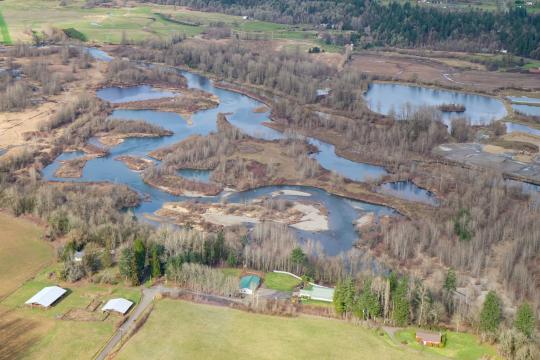 Aerial view of the Ridgefield Pits in the foreground on the East Fork Lewis River before restoration. The Daybreak Pits can also be seen and are located adjacent to the Ridgefield Pits. The project will focus on restoring the nine Ridgefield Pits. Credit: Lower Columbia Estuary Partnership
Aerial view of the Ridgefield Pits in the foreground on the East Fork Lewis River before restoration. The Daybreak Pits can also be seen and are located adjacent to the Ridgefield Pits. The project will focus on restoring the nine Ridgefield Pits. Credit: Lower Columbia Estuary Partnership
Washington State River Restoration Project to Revive Salmon Habitat, Support Local Jobs
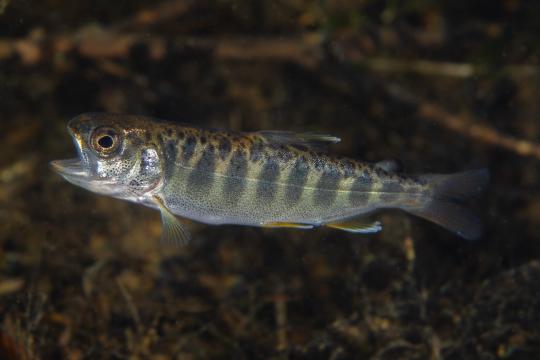 Chinook salmon. (Credit: NOAA Fisheries)
Chinook salmon. (Credit: NOAA Fisheries)
Microsoft Provides AI and Cloud Computing for NOAA Project to Better Map Prime Salmon Habitat
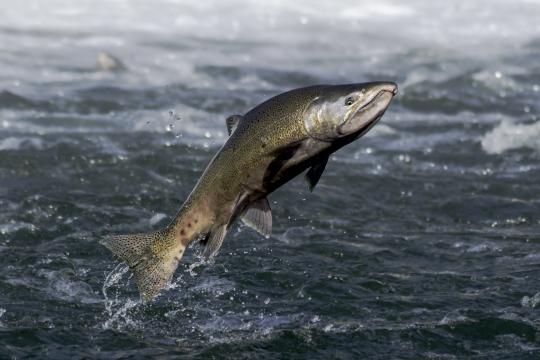 A Chinook salmon jumping out of the water. Credit: iStock
A Chinook salmon jumping out of the water. Credit: iStock
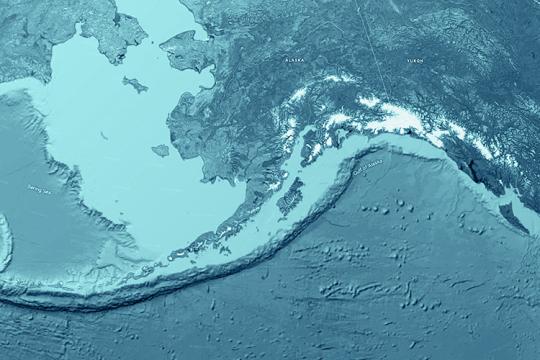 3D render and imaging of topographic map of Alaska showing the Gulf of Alaska, Aleutian Islands and Bering Sea. Satellite images courtesy of NASA. Credit: Frank Ramspott
3D render and imaging of topographic map of Alaska showing the Gulf of Alaska, Aleutian Islands and Bering Sea. Satellite images courtesy of NASA. Credit: Frank Ramspott
Seafood Facts

Is Chum Salmon Sustainable?
U.S. wild-caught chum salmon is a smart seafood choice because it is sustainably managed and responsibly harvested under U.S. regulations.
Availability
Fresh from late summer to spring and frozen and canned year-round.
Source
U.S. wild-caught from Alaska and Washington and occasionally Oregon.
Taste
Chum salmon has a lower oil content than other wild salmon, so it has a relatively mild flavor.
Texture
Firm and meaty.
Color
Raw chum is orange, pink, or red and is paler than sockeye, coho, and Chinook salmon.
Health Benefits
Chum salmon is low in sodium and a good source of omega-3 fatty acids, protein, niacin, vitamin B12, and selenium.
Nutrition Facts
Servings: 1; Serving Weight: 100 g (raw); Calories: 120; Protein: 20.14 g; Total Fat: 3.77 g; Total Saturated Fatty Acids: 0.84 g; Carbohydrate: 0 g; Total Sugars: 0 g; Total Dietary Fiber: 0 g; Cholesterol: 74 mg; Selenium: 36.5 mcg; Sodium: 50 mgMore Information
Chum Salmon Recipes
Chum salmon’s mild flavor and low oil content makes a delicious soup or curry. If you’re looking for cooking inspiration, browse these recipes for salmon chowder, sheet pan salmon, and more!
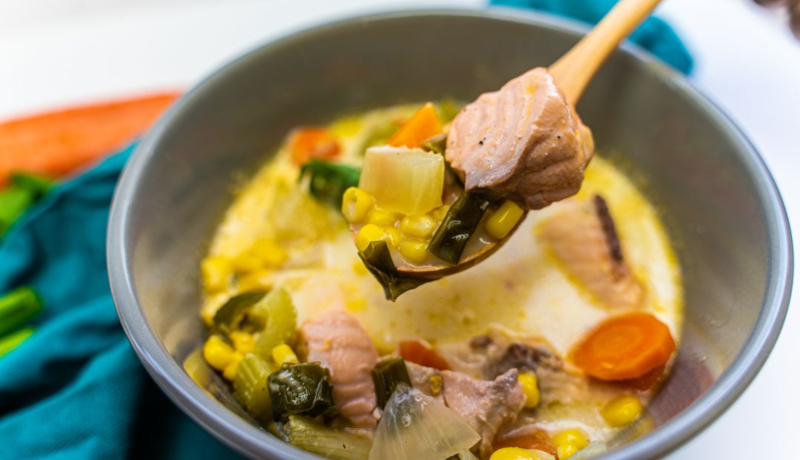
Last updated by NOAA Fisheries on 04/01/2025
Seafood News
 Celebrate Culinary Arts Month with a sustainable seafood recipe for every month of the year.
Celebrate Culinary Arts Month with a sustainable seafood recipe for every month of the year.
What Your Birth Month Says About Your Next Seafood Recipe
 Fresh-caught taʻape on ice. Credit: Conservation International Hawaiʻi.
Fresh-caught taʻape on ice. Credit: Conservation International Hawaiʻi.
Reducing Waste and Feeding Communities in Hawaiʻi with a Whole Fish Approach
 Chef Tyler Hadfield’s Curried Skate Wings with Tomato-Masala Chutney
Chef Tyler Hadfield’s Curried Skate Wings with Tomato-Masala Chutney
Ring In the New Year With These Crowd-Favorite Seafood Recipes
 NOAA Fisheries, in collaboration with Blue Ocean Mariculture, is conducting a multi-year pilot study to evaluate observational methods and tools for studying Hawaiian monk seal behavior. Courtesy of Blue Ocean Mariculture
NOAA Fisheries, in collaboration with Blue Ocean Mariculture, is conducting a multi-year pilot study to evaluate observational methods and tools for studying Hawaiian monk seal behavior. Courtesy of Blue Ocean Mariculture
AI Meets Aquaculture to Study Hawaiian Monk Seal Interactions With Net Pens
Last updated by NOAA Fisheries on 04/01/2025
Population Status
- Alaska:
- As of 2025, there were hundreds of stocks of chum salmon in Alaska.
- Some stocks are in decline, while others are steady or increasing.
- None are listed under the Endangered Species Act (ESA).
- The Alaska Coho Salmon Assemblage consists of coho salmon, sockeye salmon, pink salmon, and chum salmon throughout southeast Alaska. There are 3 indicator stocks of coho salmon that are used to determine the status of the assemblage; these indicator stocks are Auke Creek, Berners River, and Hugh Smith Lake. According to the 2022 Hugh Smith Lake, Auke Creek, and Berners River stock assessments, these stocks are not overfished and not subject to overfishing. Summary stock assessment information can be found on Stock SMART.
- West Coast:
- Two populations of chum salmon are listed as threatened under the ESA.
- Populations are affected by:
- Changes in ocean and climatic conditions.
- Habitat loss from dam construction and urban development.
- Degraded water quality from agricultural and logging practices.
- Population conservation efforts include:
- Captive-rearing in hatcheries.
- Removal and modification of dams that obstruct salmon migration.
- Restoration of degraded habitat.
- Acquisition of key habitat.
- Improvements to water quality and instream flow.
- The Pacific Coastal Salmon Recovery Fund supports the restoration of salmon species.
Fishery Management
- NOAA Fisheries and the Pacific Fishery Management Council manage chum salmon on the West Coast.
- Managed under the Pacific Coast Salmon Plan:
- All Pacific salmon species fall under the jurisdiction of this plan, although it currently only provides fishery management objectives for Chinook, coho, pink, and any salmon species listed under the Endangered Species Act.
- There are no directed fisheries for chum salmon in federal waters in this area, and chum salmon are rarely caught in the fisheries managed by the council.
- Chum salmon are caught primarily in inland waters (such as Puget Sound and Hood Canal) where fisheries are managed to ensure that conservation objectives are met.
- NOAA Fisheries and the North Pacific Fishery Management Council manage chum salmon in Alaska.
- Managed under the Fishery Management Plan for Salmon Fisheries in the EEZ off the Coast of Alaska:
- All management of the salmon fisheries in federal waters is delegated to the State of Alaska, which is also responsible for managing the commercial, recreational, and subsistence fisheries for salmon in state waters. This ensures that management is consistent throughout salmon’s range.
- Managers regulate the fishery based on escapement goals to ensure harvests are sustainable. They want enough salmon to be able to escape the fishery and return to fresh water to spawn and replenish the population.
- Salmon fishery management largely relies on in-season assessment of how many salmon return to fresh water to spawn.
- Managers set harvest levels based on these returns. When abundance is high and the number of fish returning is much higher than that needed to meet escapement goals, harvest levels are set higher.
- In years of low abundance, harvest levels are lowered.
- During the fishing season, scientists monitor catch and escapement, comparing current returns with those from previous years, to keep an eye on abundance and actively manage the fishery.
- All management of the salmon fisheries in federal waters is delegated to the State of Alaska, which is also responsible for managing the commercial, recreational, and subsistence fisheries for salmon in state waters. This ensures that management is consistent throughout salmon’s range.
- Off the West Coast and in Alaska, the Pacific Salmon Treaty and the Pacific Salmon Commission help coordinate management, research, and enhancement of shared U.S. and international salmon stocks, including chum.//
Harvest
- Commercial fishery:
- In 2023, commercial landings of chum salmon totaled 121 million pounds and were valued at $67 million, according to the NOAA Fisheries commercial fishing landings database.
- Most of the chum harvest comes from Alaska (99%). They are also harvested in Washington.
- Gear types, habitat impacts, and bycatch:
- Purse seines and gillnets are used to catch chum salmon.
- Purse seiners catch salmon by encircling them with a long net and drawing the bottom closed to capture the fish.
- Gillnetters catch salmon by setting curtain-like nets perpendicular to the salmon’s trajectory as they migrate along the coast toward fresh water.
- Chum salmon are also caught in commercial troll fisheries for Chinook and coho salmon.
- Fishing gear used to catch chum salmon rarely contacts the ocean floor and has little impact on habitat.
- Bycatch is low and usually consists of other salmon species.
- Recreational fishery:
- Salmon are a favorite catch of recreational fishermen.
- Recreational fishermen use a variety of fishing gear to harvest chum salmon.
- To ensure recreational fisheries are sustainable, West Coast anglers are only allowed to keep a certain number of salmon per fishing trip.
- In Alaska, regulations vary by area and individual fisheries.
- Recreational fisheries in high-use areas (Cook Inlet, Southeast Alaska, Copper River) are regulated through management plans that allocate fish between competing commercial and recreational fishermen.
- Subsistence fishery:
- Salmon is an important source of spiritual and physical sustenance for Western Indian tribes and Alaska natives, and salmon are culturally important to many other residents of these areas.
- Subsistence fishermen use a variety of fishing gear to harvest chum salmon.
Last updated by NOAA Fisheries on 04/01/2025
Science Overview

NOAA Fisheries conducts various research activities on the biology, behavior, and ecology of chum salmon. The results of this research are used to inform management decisions for this species. Chum salmon have not been assessed.
Chum Salmon Research in Alaska
Our work to forecast salmon harvests, assess the impact of commercial fisheries on salmon, and evaluate how salmon populations respond to environmental changes enable us to estimate abundance and trends for chum salmon in Alaska.
More on salmon research in Alaska
Chum Salmon Research in the Pacific Northwest
Our research on Pacific salmon covers several topics including bycatch, salmon harvest forecasts, ecotoxicology, genetics, marine survival and responses to climate change.
Last updated by NOAA Fisheries on 04/01/2025
Documents
Cook Inlet Small Entity Compliance Guide
The Small Entity Compliance Guide (select "View Document" below) contains a summary of regulations…
Alaska Salmon Task Force Meeting Minutes January 25, 2024
Alaska Salmon Task Force Meeting Minutes for January 25, 2024.
Alaska Salmon Task Force Meeting Minutes November 14, 2023
Alaska Salmon Task Force Meeting Minutes for November 14, 2023.
Alaska Salmon Task Force Meeting Minutes September 19, 2023
Alaska Salmon Task Force Meeting Minutes for September 19, 2023.
Data & Maps
2021 Genetic Stock Composition Analysis of Chum Salmon From the Prohibited Species Catch of the Bering Sea Walleye Pollock Trawl Fishery and Gulf of Alaska Groundfish Fisheries
Alaska Fisheries Science Center Salmon Bycatch Report
2020 Genetic Stock Composition Analysis of Chum Salmon From the Prohibited Species Catch of the Bering Sea Walleye Pollock Trawl Fishery and Gulf of Alaska Groundfish Fisheries
Alaska Fisheries Science Center Salmon Bycatch Report
Research
NOAA Live! Alaska Season 5: 2024-25
NOAA Live! Alaska is a series of webinars that connects NOAA scientists and partners with students, teachers, and Alaska communities. In 2024-25, we are featuring NOAA programs and partners in Alaska communities.
GoToWebinar Registration and Joining Instructions
How to register and join meetings for the Alaska Salmon Research Task Force
Outreach & Education
Oral History of Chum Salmon: The Tails of The Legendary Kuskokwim Salmon
Presentation poster
Alaska Salmon Research Task Force Report
Report from the Alaska Salmon Research Task Force
Alaska Salmon Research Task Force Meeting Agenda—March 27, 2024
Alaska Salmon Research Task Force Meeting Agenda for March 27, 2024
¡Cuento con usted! edición salmón (en español)
Aprenda a administrar el salmón responsablemente.
Last updated by NOAA Fisheries on 04/01/2025




